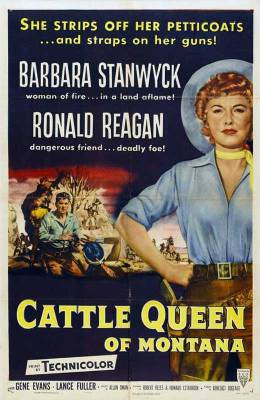NOTE: This review was written for the Barbara Stanwyck Filmography Project. For more Stanwyck reviews, visit the dedicated project index!
Pop Jones (Morris Ankrum) is headed to Montana with his daughter Sierra Nevada (Barbara Stanwyck) and cowhand Nat (Chubby Johnson), leaving their Texas ranch behind for a new start on an inherited plot of land.

One day, while exploring her new surroundings, Sierra Nevada encounters a stranger named Farrell (Ronald Reagan), who warns her of potential attacks by the local Blackfoot tribe.
Unbeknownst to Sierra Nevada or Pop, a faction from this tribe is working with wealthy rancher Tom McCord (Gene Evans), who wants the rights to the Jones’ land.
Sierra Nevada finds that she must team up with Farrell and friendly Blackfoot man Colorados (Lance Fuller), in order to save her father’s land.
Cattle Queen of Montana was directed by Allan Dwan. The film was scripted by Robert Blees and Howard Estabrook, from a story by Thomas Blackburn.
My own complicated history with Westerns has seen the genre go from my least favorite to one that I find very enjoyable… under certain conditions. As long-time readers of TMP will know, in my quest to appreciate Westerns, there’s been one pet peeve I haven’t been able to get over, and that’s the demonization/mistreatment of indigenous characters.
Cattle Queen of Montana is an interesting film in respect to this issue. It certainly isn’t without its problems. In one scene, Sierra Nevada literally yells “Killers! Savages, all of you!,” and Colorados, the “good Indian” of the story, has a rift with his traditional, tribal-chief father over his decision to attend school. And then, of course, all of the native characters are played by white men in wigs and bad makeup.
But in its portrayal of the relationship between the settlers and the natives, the film’s script offers a more complex exploration. Issues such as the loss of land and hunting ground are discussed. Colorados seeks to help Sierra Nevada and her fellow settlers understand that his people aren’t evil, asking directly, “Is it so hard to believe that I’m a human being, too?” He succeeds in enlightening Sierra, leading to a disgusting-but-accurate portrayal of the vitriol she faces in town after being seen simply riding her horse next to Colorados.

The general perspective of the film seems to be that there is good and evil in every social group. Divisions of race, class, religion, and politics don’t separate people into monolithic communities, because these communities are made up of individuals, some of whom are bound to be peace-seekers and some of whom are bound to be extremists.
Or, maybe I’m reading too much into it, and it’s just an easy time-passer of a Western film, haha. It works, in that respect. Some lovely photography showcases the beauty of the land, and the story did a fine job of keeping my interest.
As for Stanwyck, her performance here isn’t as high-energy or high-impact as in some of her other roles, but the film is still an okay watch and she turns out a solid performance. This would be a more memorable entry into her filmography had her character been more deeply developed, giving her more meaty material to work with.
Cattle Queen of Montana isn’t one of Stanwyck’s best, but it’s got a decent story, and Western fans will enjoy it for the scenery at the very least.